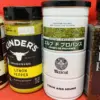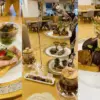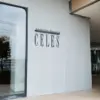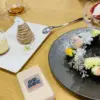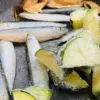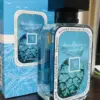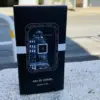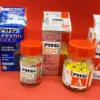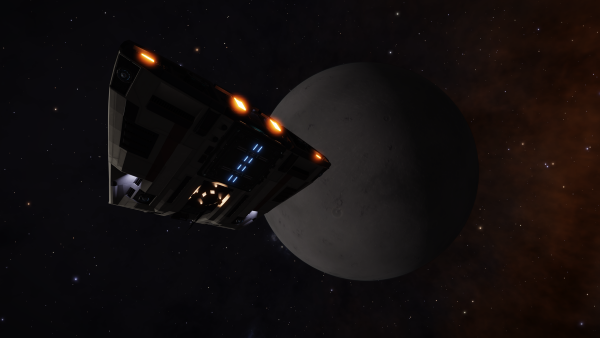アセスルファムKの危険性と安全性評価【人工甘味料・食品添加物】

アセスルファムKは微量であれば身体に異常は引き起こさない人工甘味料ですが、1日の安全摂取許容量0.45g以上(体重50kgの人)の摂取は、アセスルファムK過剰摂取によるDNA損傷のリスクがあるため、これを多く含む清涼飲料水や甘いコーヒー飲料の飲み過ぎはやめるべきです。
アセスルファムKの化学的性質と詳細
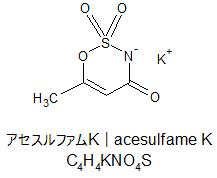
アセスルファムK(Acesulfame K|IUPAC:potassium 6-methyl-2,2-dioxo-2H-1,2λ6,3-oxathiazin-4-olate|カリウム 6-メチル-2,2-ジオキソ-オキサチアジン-4-オラート)は、化学式C4H4KNO4S、モル質量201.24g/mol、水への溶解度270g/L(20℃)の人工甘味料で、甘さはショ糖の200倍ほどです。
甘味はありますが、カロリーはほぼなく、血糖値をほとんど上げないので、減量・ダイエットを目的にしている方や、糖尿病患者向けの食事の添加物として利用できます。アセスルファムKは、甘味を感じた後の後味に若干の「苦味」を感じる人もいます。
アセスルファムKの危険性評価
Doses of 15, 30, 60, 450, 1500 and 2250 mg of acesulfame-K/kg body weight induced a positive dose-dependent significant clastogenicity (trend test α < 0.05). These doses were within the no-toxic-effect levels (1.5-3 g/kg body weight in rats) reported by the Joint Expert Committee for Food Additives of the World Health Organization and the Food and Agriculture Organization of the United Nations.
引用元:https://www.sciencedirect.com/science/article/abs/pii/S0278691597854695
WHO(世界保健機関)とFAO(国連食糧農業機関)が定めている無毒効果レベル(ラット:1.5〜3g/kg体重)の範囲内ではあるものの、染色体異常誘発性があったと報告されています。アセスルファムKの単発・微量摂取程度では問題はないと考えられますが、慢性的に大量に摂取するのは控えるべきでしょう。
The comet parameters of DNA were increased in the bone marrow cells due to the sweetener-induced DNA strand breaks, as revealed by increased comet-tail extent and percent DNA in the tail. ASK and saccharin were found to induce greater DNA damage than ASP.
引用元:https://www.tandfonline.com/doi/abs/10.1080/01480540802390270
別の論文においてもアセスルファムKはDNA損傷を起こす可能性が高いとされており、慢性的に過剰摂取するのは避けるべきでしょう。
アセスルファムKに発がん性・がん誘発性はない
Except for the toxicological animal data required for FDA approval, there are no larger studies that investigate the potentially hazardous effects of second generation sweeteners. None of the substances such as acesulfame-K, neohisperidine, alitame or sucralose has been suspected to cause cancer or to be genotoxic.
引用元:https://www.sciencedirect.com/science/article/pii/S0923753419510377
新世代甘味料として、アセスルファムKは発がん性はないと考えられると報告されていますが、大量摂取させて発がん性を調べる研究は足りていない可能性もあります。通常の、常識的な含有量ではアセスルファムKが、がんを誘発するとは断言できません。
The sweeteners saccharin (SAC) and acesulfame K (ACE) recently entered the topic of anticancer human carbonic anhydrase (CA, EC 4.2.1.1) inhibitors, as they showed to selectively inhibit the tumor-associated CAs IX/XII over ubiquitous CAs. A drug design strategy is here reported, which took SAC and ACE as leads and produced a series of 2H-benzo[e][1,2,4]thiadiazin-3(4H)-one-1,1-dioxides (BTD).
引用元:https://pubs.acs.org/doi/abs/10.1021/acs.jmedchem.9b01669#
発がん性が認められないどころか、腫瘍関連の一部の進行を阻害する機能がある可能性があるとまで言われており、アセスルファムKに発がん性があるとは言えません。
フランスで、人工甘味料が含まれる飲み物の摂取と発がんについて調査された研究があります(リンク)が、これは食事、たばこ、お酒、生活スタイルの影響を考慮できておらず、年齢、性別などもバラバラで、アセスルファムKの発がん性を証明できるレベルのデータになっていませんでした。
人工甘味料を多く摂取している消費者層
In total, 102,865 participants (78.5% women) were included in the analyses (detailed flowchart shown in Fig 1). Average age at baseline was 42.2 ± 14.5 years. Average number of 24-hour dietary records per participant was 5.6 (SD = 3.0). Artificial sweeteners were consumed by 36.9% of the participants. Table 1 shows baseline characteristics of the study population by categories of total artificial sweetener intake.
Compared to non-consumers (unadjusted descriptive comparisons), higher consumers tended to be more often women, younger, smokers, less physically active, more educated, and more likely to have prevalent diabetes.
They had lower energy, alcohol, saturated fatty acid, fibre, fruit and vegetables, and whole-grain food intakes and higher intakes of sodium, total sugar, dairy products, sugary foods and drinks, and unsweetened non-alcoholic beverages.
The main artificial sweetener was aspartame, contributing to 58% of intakes, followed by acesulfame-K (29%) and sucralose (10%) (Fig 2). These 3 sweeteners were respectively consumed by 28%, 34%, and 14% of the study population. All participants’ intakes of aspartame and acesulfame-K were below the ADIs of 40 mg/kg body weight/day and 9 mg/kg body weight/day, respectively; only 5 participants exceeded the ADI of 15 mg/kg body weight/day for sucralose [5].
興味深いデータとして取り上げると、102,865人(女性が78.5%)の14.5歳~42.2歳を対象にした調査では、36.9%の人が、過去24時間に人工甘味料を消費していたという報告があります。これは、過去24時間に、37,957人が人工甘味料を摂取しているということで一つの参考になります。
また、人工甘味料を消費している人の属性は
- 女性
- 若者
- 喫煙者
- 運動不足
- 教育水準が高め
- 糖尿病気味
と報告されており、エネルギー、アルコール、飽和酪酸、繊維、果物と野菜、全粒穀物の食物摂取量が少なかったとのことです。逆に、ナトリウム、全糖、乳製品、甘い食べ物と飲み物、無糖の非アルコール飲料の摂取量が多かったとされています。いわゆる生活習慣病の要因になるものと似ています。
この調査で消費された人工甘味料の割合は、
- アスパルテーム:58%
- アセスルファムK:29%
- スクラロース:10%
だったとも報告されています。しかし、この調査では、一日の安全摂取量より少ない量しか摂取していないため、リスクはそれほどないと考えられます。
アセスルファムKの安全性評価
EUのScientific Committee on Food (SCF)では、アセスルファムKの1日の安全摂取量(ADI:摂取許容量)を「9mg/kg体重」と定めています。これは、体重50kgの大人に当てはめると
9mg × 50 = 450mg
450mg = 0.45g
となります。
日本国内においては、公益財団法人「日本食品化学研究振興財団」の資料(リンク)によると、アセスルファムKを含んで良い含有量は
- 生菓子、菓子及びあん類:2.5g/kg
- ジャム類、漬け物、氷菓、アイスクリーム、たれ及びフラワーペースト:1.0g/kg
- 果実酒、雑酒、清涼飲料水、乳飲料、乳酸菌飲料及びはっ酵乳:0.50g/kg
- 砂糖代替食品:15g/kg
- その他の食品:0.35g/kg
とされており、それぞれ1kgあたりにごく微量しか含められないよう制限されています。EUの定める安全許容量、体重50kgの人は1日0.45gまでという条件を満たすには、アセスルファムKを含む「果実酒、雑酒、清涼飲料水、乳飲料、乳酸菌飲料及びはっ酵乳」を1Lほど飲めば、安全摂取量をオーバーします。
アセスルファムKを多く含む2Lペットボトルのジュースを1日1本飲むのはアセスルファムKの摂取量が多すぎることになります。
- 清涼飲料水
- 甘いコーヒー飲料
- 甘い乳製品系
- 甘い炭酸ジュース
- 野菜ジュース
- 缶チューハイ
これらの飲み物は控えたほうが良いでしょう。1日に350mlだけの摂取であれば、安全摂取許容量を超えないと考えられますが、午前中に甘い缶コーヒー200mlと清涼飲料水500mlを消費、お昼に野菜ジュース200ml、午後にカフェオレ飲料500ml、夜は缶チューハイ500mlを飲んでいたら、完全にアセスルファムKの安全摂取量オーバーと考えたほうが良いです。
強い発がん性はなくとも、DNA損傷の可能性があるため、長い目で見れば、また、極端に言えば、精子の奇形が増えるとか、傷の治りが遅くなるとか、細胞新生に狂いが生じる(転じて、癌になる可能性もある)ため、アセスルファムKを多く含んでいる飲料には注意が必要です。
実際のアセスルファムKの含有量は、ここで想定しているよりも少ない量のはずですが、含有量が記載されていない以上は、減らす方向で考えるべきです。さらに、フェニルケトン尿症の方は、アセスルファムKを含む飲料は控えたほうが良いでしょう。
出典・参考
Safety of the proposed extension of use of acesulfame K (E 950) in foods for special medical purposes in young children
https://efsa.onlinelibrary.wiley.com/doi/abs/10.2903/j.efsa.2016.4437
Artificial sweeteners and cancer risk: Results from the NutriNet-Santé population-based cohort study
“A Sweet Combination”: Developing Saccharin and Acesulfame K Structures for Selectively Targeting the Tumor-Associated Carbonic Anhydrases IX and XII
https://pubs.acs.org/doi/abs/10.1021/acs.jmedchem.9b01669#
Artificial sweeteners—do they bear a carcinogenic risk?
https://www.sciencedirect.com/science/article/pii/S0923753419510377
In vivo cytogenetic studies on mice exposed to acesulfame-K—A non-nutritive sweetener
https://www.sciencedirect.com/science/article/abs/pii/S0278691597854695
Genotoxicity Testing of Low-Calorie Sweeteners: Aspartame, Acesulfame-K, and Saccharin
https://www.tandfonline.com/doi/abs/10.1080/01480540802390270
Bitter Taste Receptors for Saccharin and Acesulfame K
https://www.jneurosci.org/content/24/45/10260.full
指定添加物リスト|公益財団法人 日本食品化学研究振興財団 事務局
https://www.ffcr.or.jp/tenka/list/post-11.html
各添加物の使用基準及び保存基準|公益財団法人 日本食品化学研究振興財団 事務局
https://www.ffcr.or.jp/webupload/74a51493d997785a77ea40142cf05a79c6b52db7.pdf
食品添加物|厚生労働省
https://www.mhlw.go.jp/stf/seisakunitsuite/bunya/kenkou_iryou/shokuhin/syokuten/index.html
第二世代の糖アルコール
https://www.bfsci.co.jp/pdf/catalogue/03.pdf





